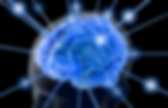

The Book of Lambspring, text an Interpretation of this Alchemical manuscript. I am called Lambspring, born of a Noble Family, and this Crest I bear with Glory and Justice.
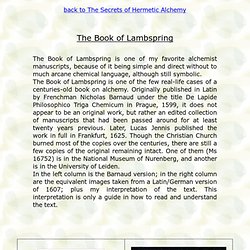
Philosophy I have read, and thoroughly understood, The utmost depth of my teachers' knowledge have I sounded. This God graciously granted to me, Giving me a heart to understand wisdom. Thus I became the Author of this Book, And I have clearly set forth the whole matter, That Rich and Poor might understand.
There is nothing like it upon earth; Nor (God be praised) have I therein forgotten my humble self. I am acquainted with the only true foundation: Therefore preserve this Book with care, And take heed that you study it again and again. "Study it again and again": a mere intellectual interpretation is not sufficient, one must gain understanding by contemplating the text and images. The emphasis on directing one's attention to God, or Jesus Christ can be found in several alchemical manuscripts.
Alchemy, Theory, Science, Symbolism, Ancient Wisdom, Egypt, and Influences. Much of Alchemy is misunderstood and shrouded in mystery within magickal and fraternal orders, it is our goal to unravel some of the aspects which remain hidden behind conventional history.
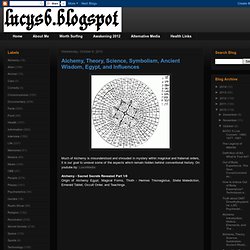
On youtube by: LuxorMedia Alchemy - Sacred Secrets Revealed Part 1/8Origin of Alchemy Egypt, Magical Forms, Thoth - Hermes Trismegistus, Stella Malediction, Emerald Tablet, Occult Order, and Teachings. Alchemy - Sacred Secrets Revealed Part 2/8 Alchemy known as "The Great Work" is broken into several chemical: PsychologicalSociologicalTheologicalSocietal Planetary Levels Alchemy works with the; "Three Primes" or "Tria Prima" 1. Four Basic Elements:Earth, Fire, Wind, Water Alchemy - Sacred Secrets Revealed Part 3/81. Alchemy - Sacred Secrets Revealed Part 4/86. Alchemy - Sacred Secrets Revealed Part 1/8. Solve Et Coagula - The Great Work of Alchemy. Kymatica (2009) Virtual Art Gallery of Alchemical Emblems. Sixteenth Century Floor Rosarium philosophorum room Four side galleriesEarly Period Floor Early Europe Floor Sixteenth Century Floor Seventeenth Century Floor Eighteenth Century Floor Floorplan Back to alchemy website The Rosarium philosophorum (the Rosary of the Philosophers) was first printed at Frankfurt in 1550 as the second part of an alchemical compendium De Alchimia opuscula complura veterum philosophorum.

Its has nothing to do with the Catholic idea of the rosary, but this term 'Rosarium' referred to a gathering of sayings of philosophers. The Latin text of the Rosarium is just this, a collection of the sayings of alchemical and other philosophers. The text is in itself quite interesting but it very much enlivened by the inclusion of a series of 20 woodcuts. There is a further woodcut on the title page which shows six philosophers disputing and this links us with the idea of a 'Rosarium' as a collection of their sayings. The Rosarium series of 20 woodcuts British Library MS.
Alchemical symbol. Alchemical symbols in Torbern Bergman's 1775 Dissertation on Elective Affinities Alchemical symbols, originally devised as part of alchemy, were used to denote some elements and some compounds until the 18th century.
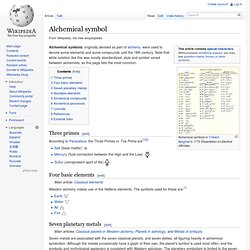
Note that while notation like this was mostly standardized, style and symbol varied between alchemists, so this page lists the most common. Three primes[edit] According to Paracelsus, the Three Primes or Tria Prima are[1][2] Four basic elements[edit] Western alchemy makes use of the Hellenic elements. [edit] Seven metals are associated with the seven classical planets, and seven deities, all figuring heavily in alchemical symbolism. Mundane elements[edit] Alchemical compounds[edit] A table of alchemical symbols from Basil Valentine's The Last Will and Testament, 1670 Alchemical processes[edit] Unicode[edit] Unicode 6.1 adds support for an Alchemical Symbols block. References[edit] ^ Jump up to: a b c Eric John Holmyard. External links[edit] Alchemical symbols in Unicode 6.0. Chinese alchemy. Chinese alchemy is a part of the larger tradition of Taoist body-spirit cultivation that developed from the traditional Chinese understanding of medicine and the body.
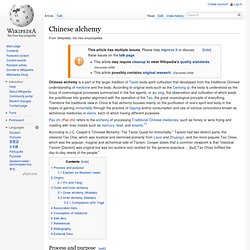
According to original texts such as the Cantong qi, the body is understood as the focus of cosmological processes summarized in the five agents, or wu xing, the observation and cultivation of which leads the practitioner into greater alignment with the operation of the Tao, the great cosmological principle of everything. Therefore the traditional view in China is that alchemy focuses mainly on the purification of one's spirit and body in the hopes of gaining immortality through the practice of Qigong and/or consumption and use of various concoctions known as alchemical medicines or elixirs, each of which having different purposes. According to J.C. Process and purpose[edit] By refining bases into gold, the alchemist believed that immortal life would be delivered if the "fake" or synthetic gold was ingested.